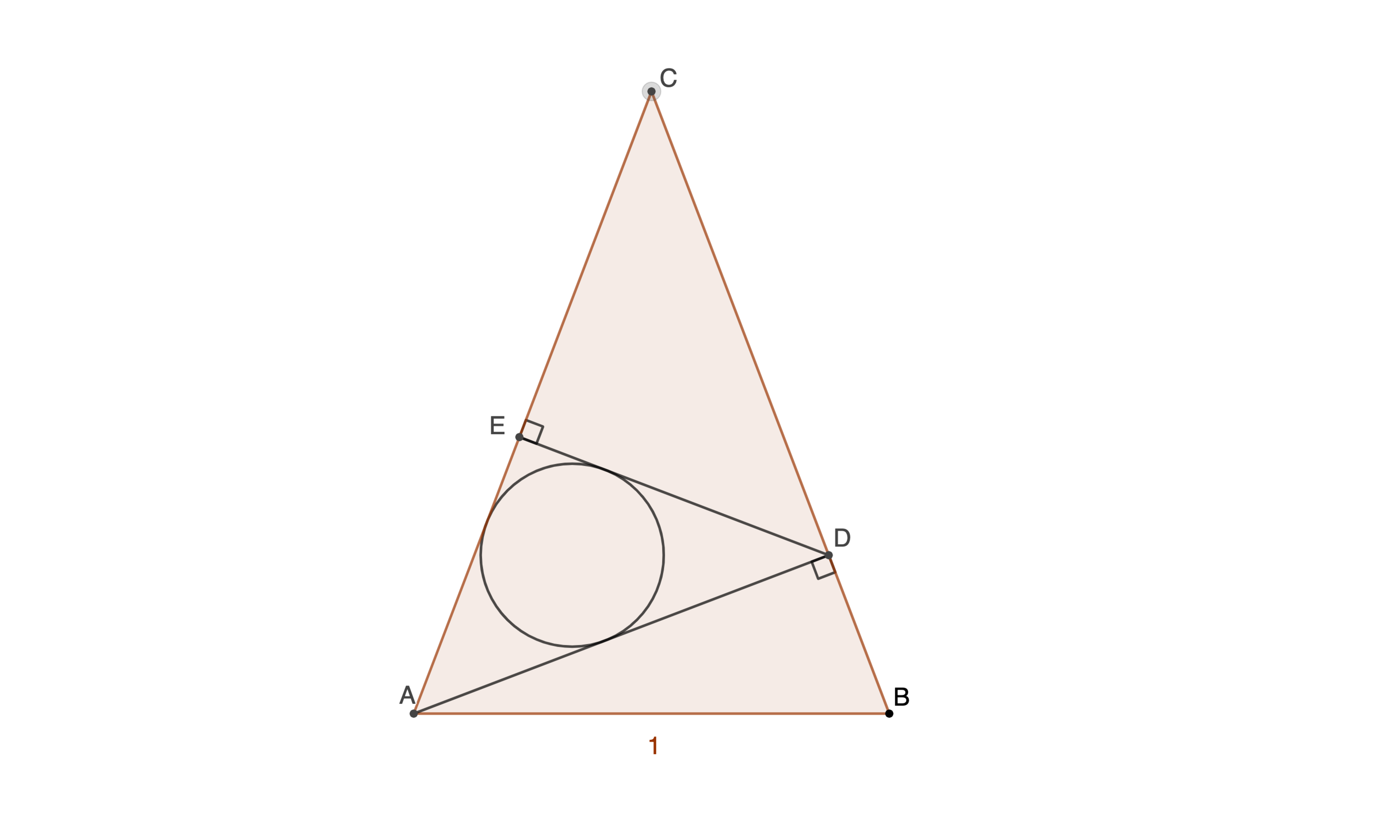Big circle, right angles, isosceles triangle

△ A B C is an isosceles triangle with a base length of 1 . A D ⊥ C B and E D ⊥ A C . E is chosen to maximize the radius, r , of the incircle of △ A D E . If r = q p , where p and q are positive integers and p is square-free, submit p + q .
The answer is 12.
This section requires Javascript.
You are seeing this because something didn't load right. We suggest you, (a) try
refreshing the page, (b) enabling javascript if it is disabled on your browser and,
finally, (c)
loading the
non-javascript version of this page
. We're sorry about the hassle.
1 solution
My angle θ was ∠ A B C and my function was r ( θ ) = ( sin 2 θ ( sin θ + cos θ ) ) . Then for the first derivative I got r ′ ( θ ) = 2 sin θ ( 3 sin 2 θ + 3 cos 2 θ + 1 ) Of course, θ 0 = 0 gives a minimal r so we should set the bracket equal to zero. Using the universal substitution t = tan θ 0 the equation simplifies to the quadratic t 2 − 3 t − 2 = 0 and gives tan θ 0 = t = 2 3 ± 1 7 Since θ is an acute angle, then all it's trig functions are positive and we'll take the positive t . This means sin θ 0 = 6 ( 5 + 1 7 ) 3 + 1 7 and cos θ 0 = 6 ( 5 + 1 7 ) 2 Finally r max = r ( θ 0 ) , which simplifies to r max = 6 1 3 7 1 + 1 7 1 7
If someone is willing to take the time to find my mistake, I will be very very grateful. :)
Let ∠ A C B = 2 θ . Let M be the center of the circle and N its point of contact with A C . Then
∠ D A B = 9 0 ∘ − ∠ D B A = 9 0 ∘ − 2 1 8 0 ∘ − ∠ A C B = 9 0 ∘ − 2 1 8 0 ∘ − 2 θ = θ Hence, A D = A B cos θ ⇒ A D = cos θ Consequently,
A E = A D cos ( 9 0 ∘ − 2 θ ) ⇒ A E = cos θ ⋅ sin ( 2 θ ) ( 1 ) Moreover,
∠ N A M = 2 ∠ C A D = 2 9 0 ∘ − 2 θ = 4 5 ∘ − θ Hence,
A E = A N + N E = r cot ( 4 5 ∘ − θ ) + r ⇒ A E = r ( cot ( 4 5 ∘ − θ ) + 1 ) ( 2 ) Combining ( 1 ) and ( 2 ) we have a function for r w.r.t. θ :
r ( cot ( 4 5 ∘ − θ ) + 1 ) = cos θ ⋅ sin ( 2 θ ) ⇔ r = cot ( 4 5 ∘ − θ ) + 1 cos θ ⋅ sin ( 2 θ ) = cot θ − 1 cot θ + 1 + 1 2 sin θ cos 2 θ = cot θ − 1 2 cot θ 2 sin θ cos 2 θ = sin θ cos θ − 1 sin θ cos θ sin θ cos 2 θ ⇔ r = sin θ cos θ ( cos θ − sin θ ) ⇔ r = 2 2 sin 2 θ sin ( 4 5 ∘ − θ ) , θ ∈ ( 0 ∘ , 9 0 ∘ ) Taking the derivative
d θ d r = 0 ⇔ 2 2 [ 2 cos ( 2 θ ) sin ( 4 5 ∘ − θ ) − sin ( 2 θ ) cos ( 4 5 ∘ − θ ) ] = 0 ⇔ 2 cos ( 2 θ ) sin ( 4 5 ∘ − θ ) = sin ( 2 θ ) cos ( 4 5 ∘ − θ ) ⇔ 2 tan ( 4 5 ∘ − θ ) = tan ( 2 θ ) ⇔ 2 1 − tan θ 1 − tan θ = 1 − tan 2 θ 2 tan θ ⇔ tan 2 θ − 3 tan θ + 1 = 0 ⇔ tan θ = 2 3 ± 5 θ = tan − 1 ( 2 3 ± 5 ) Studying the sign of the derivative we see that r ( θ ) has a maximum at θ = θ 0 = tan − 1 ( 2 3 − 5 ) .
For this value of θ we have
r = sin θ 0 cos θ 0 ( cos θ 0 − sin θ 0 ) = 1 + tan 2 θ 0 tan θ 0 ⋅ 1 + tan 2 θ 0 1 ( 1 + tan 2 θ 0 1 − 1 + tan 2 θ 0 tan θ 0 ) = 1 + ( 2 3 − 5 ) 2 2 3 − 5 ⋅ 1 + ( 2 3 − 5 ) 2 1 − 2 3 − 5 = … = 9 3 For the answer, p = 3 , q = 9 , thus, p + q = 1 2 .